Posted by Anita on 02.16.09 11:52 PM
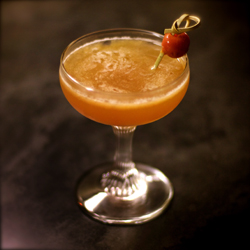 The great irony of these troubled economic times is that cocktail budgets are shrinking just at the time when many of us really could use a strong drink. And even if you’ve survived the entire economic downturn syndrome — the downsizing, the furloughs, the real-estate bubble, and the credit crunch — unscathed, it feels a little too much like tempting fate to be drinking high on the hog while waiting for the other shoe to drop.
The great irony of these troubled economic times is that cocktail budgets are shrinking just at the time when many of us really could use a strong drink. And even if you’ve survived the entire economic downturn syndrome — the downsizing, the furloughs, the real-estate bubble, and the credit crunch — unscathed, it feels a little too much like tempting fate to be drinking high on the hog while waiting for the other shoe to drop.
And thus we find ourselves on this particular Mixology Monday with the theme Hard Drinks for Hard Times, hosted by whiskey guru Matthew Rowley. Our assignment: “Write about an alcoholic drink you’ve made that resonates with the current economic turndown.”
But even widespread austerity measures don’t have to mean the end of the civilized ritual that a properly made cocktail affords. Off the top of my head, I can think of five painless ways to keep the cocktail hour rolling when we need it the most:
Secret #1: Switch your allegiance.
Perhaps the simplest way to economize on cocktail expenses — other than to drink less — is to drink cheaper booze. Duh. But I’m not advocating that you ignore your tastebuds and buy crap, or even settle for something you don’t enjoy. (We are still drinking for the pleasure of the well-crafted cocktail, correct?)
So, for example, if you’re fond of rye (and really, who isn’t?) consider a bottle of Old Overholt for everyday mixing; save that Sazerac or Rittenhouse for sipping, or at least for the drinks where the spirit is the star of the show. The shelves are filled with quality booze that’s nearly as good as the boutique brands, at a fraction of the cost. David Wondrich wrote up five of his favorites in a recent Esquire piece; I’m hoping we’ll hear a lot more about alternative brands from other MxMo posters.
Secret #2: Share the love.
If you need just an ounce or two of some obscure liqueur, don’t be afraid to ask your friends if they’ve got a bottle you can borrow. This works especially well if you have somebody like Erik living a few blocks away, like we do. But even if you have to make a special trip across town, you’ll have an excuse to buy your pal a drink.
The ground rules are the same ones your mama taught you back when your friends were loaning you Hot Wheels and Shaun Cassidy albums: Return the item in the same condition you found it, express gratitude in an appropriate fashion, and reiterate how happy you’ll be to return the favor down the road.
 Secret #3: Think small.
Secret #3: Think small.
If you don’t have a ready network of cocktail geeks in your back yard, there’s still hope. Even the most math-challenged among us realizes that mini-bottles aren’t a great deal on an ounce-by-ounce basis. But if you only need a splash of something to test out a recipe – especially if it’s a type of liquor you aren’t sure you’ll love – tiny bottles can be a smarter bet.
A case in point: A few months back, I wanted to test a recipe that called for a small amount of Southern Comfort. But I’m not a great fan of flavored spirits, so this was a case where the $2.50 mini was a much wiser investment than the 750ml bottle at $15. (Special note to drink bloggers: Minis are often indistinguishable from their full-size counterparts in photographs, especially if you use a macro lens.)
Secret #4: Shop around.
If you’re lucky enough to live in a place that’s unencumbered by a state liquor monopoly, don’t be afraid to look for good-quality booze in unlikely places. Swanky spirits emporia may have all the beautiful bottles you need in one place, but they aren’t always a fantastic bargain. And — if you’re anything like me — it’s often impossible to get out the door without buying three (or five, or a dozen) things you couldn’t live without.
You can often find great deals at places that don’t necessarily specialize in spirits, like supermarkets (we keep our Safeway Club Card just for stocking up on staple booze), drugstores (a co-worker swears Rite-Aid has door-buster pricing on Sailor Jerry rum), and warehouse stores like Costco. Just make sure to walk straight past that twelve-pack of Swiffer refills, OK?
But when you’re clipping coupons and being an otherwise savvy consumer, don’t forget that the owner of your local quality liquor store — the one who makes great wine recommendations and offers to set aside bottles of special whiskey for you when it comes in — is also feeling the pinch. Certainly, buy your Beefeater in bulk, but when you’re getting excited about saving two bucks on a $25 bottle at the megamart, remember that if you don’t buy from the folks who really know their stuff, you’ll miss their expertise when the inevitable happens.
Secret #5: Drink seasonally.
If you’re a fan of drinks that have a substantial fruit or juice component, it pays to keep an eye on the calendar. Drink sours in the wintertime, Tequila por mi Amante in the spring, Bellinis in summertime, cobblers in the fall. Just as when you’re planning meals, follow the bumper crop for cocktail ingredients and you’ll find the best prices as the farmers market. And don’t be afraid to ask around; you may even get lucky enough to find a neighbor or co-worker with an abundance of backyard fruit to share.
If you know you won’t be able to live without your favorite fruity beverages in the off-season, consider simple preservation: Most fruits (and pretty much all juices) freeze well, and home-made cocktail cherries are among the simplest and most rewarding of spring pantry projects.
—-
In the spirit of the frugal tipple, we shook up a batch of Ward Eight cocktails — essentially a more-interesting twist on the venerable whiskey sour — using one of our favorite value-priced spirits, plus lemons from our own tree, and oranges given to us by a friend with an abundance of homegrown fruit. The grenadine is a homebrew version we keep on hand, made from store-bought pomegranate juice. The cherry garnish happens to be a gift from another thoughtful friend, but we could just as easily have used our own home-preserved version.
We’re sipping them out of gorgeous glassware, but — a-ha, an unbilled Secret #6! — we buy nearly all of our cocktail glasses secondhand. Thrift stores sell beautiful vintage glasses as cheaply as $0.50, and rarely higher than $2 a stem. An added bonus: Antique cocktail glasses are much smaller than their modern counterparts, so you can often split a single drink between two.
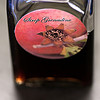
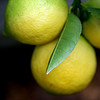

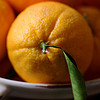
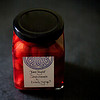
Ward Eight
2 oz rye whiskey (such as Old Overholt)
3/4 oz lemon juice
3/4 oz orange juice
1 teaspoon grenadine
Shake with ice and strain into a chilled cocktail glass.
drinks, Mixology Monday, recipes
14 Comments »




Posted by Anita on 01.19.09 10:38 PM
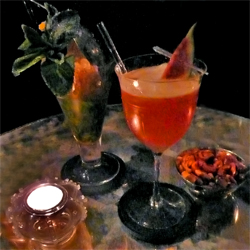 When you go to London, if you’re at all interested in the mixological arts, I recommend you bring an ample supply of cash, a large bottle of milk thistle, and a suitcase full of bubble wrap. Dear reader, they have so many wonders across the Pond that we only dream of Stateside.
When you go to London, if you’re at all interested in the mixological arts, I recommend you bring an ample supply of cash, a large bottle of milk thistle, and a suitcase full of bubble wrap. Dear reader, they have so many wonders across the Pond that we only dream of Stateside.
First among these treasures is a plethora of eye-poppingly gorgeous (not to say purse-poppingly pricey) cocktail establishments. The exchange rate is lately favourable to the American drinker, as much as can be possible. But a list of cocktails priced at £16, or £18, or even a heart-stopping £26 a sniff is bound to set even the hardiest of world travelers back on her heels. It was only the Christmas holidays and the attendant closure of many of the Capital’s top watering holes that saved us from coming home skint.
One of the key reasons for the allure of said establishments — apart from their five-star decor and their world-class staff — is the ability for a colonial to sample libations that simply never make it to our shores. Rare malts! Esoteric liqueurs! Cuban rums! The mind reels at the possibilities of the drinks that could be shaken, if only one had access to such wonders. (Happily, one does. Although London’s spirits emporia are small in number, they’re rich in merchandise, easily discovered, and more than happy to abuse your charge card in exchange for some very fragile cargo for the return flight.)
One of the best drinks we enjoyed while in London married both of these two alluring elements, the fantastically beautiful bar and the enticingly rare ingredient.
 Aided and abetted by another London treasure, Jay Hepburn — proprietor of the spectacular blog known as Oh, Gosh! — we spent an evening taxing the hospitality of not one but two of London’s luxury-hotel lounges, the Bar at The Dorchester and Connaught Bar. Though our night at The Dorchester will forever remain a highlight of our London trip (due in no small part to the extraordinary welcome we received from our gregarious barman, Stefano, and his flawless drinks that kept us so enraptured that we missed the last train of the night!), the Connaught was a stunner.
Aided and abetted by another London treasure, Jay Hepburn — proprietor of the spectacular blog known as Oh, Gosh! — we spent an evening taxing the hospitality of not one but two of London’s luxury-hotel lounges, the Bar at The Dorchester and Connaught Bar. Though our night at The Dorchester will forever remain a highlight of our London trip (due in no small part to the extraordinary welcome we received from our gregarious barman, Stefano, and his flawless drinks that kept us so enraptured that we missed the last train of the night!), the Connaught was a stunner.
It’s an opulent space, somehow embodying both splendid beauty and undeniably comfort. The staff are impeccable, gracious to a fault, and thoughtful to the utmost detail, from the first greeting to the last farewell. We were welcomed with a complimentary sip to enjoy while we perused the menu, then presented with a sheaf of recipes for the drinks we’d enjoyed at the end of the evening — an enchanting gesture that I hope will be the start of an international trend.
Though we savored many wonderful drinks that night, the final nod must go to the very first I tasted at Connaught Bar: a complex, spicy bit of exotica known as the French Sin. It’s not a simple drink to make, requiring a flavoured sugar, a barely seasonal fruit, a rare vermouth, and a carbonated tea infusion. Nevertheless, the rewards, as they say, are in the glass.
The French Sin also makes a perfect candidate for this month’s Mixology Monday: New Horizons, hosted by the anonymous Scribe of A Mixed Dram. Encouraged to sample a new spirit (amber vermouth, check!) or a new technique (carbonating tea — check again!), the French Sin covers all the bases. But if for some reason, you can’t be bothered to fizz your own tea, procure a bottle of rare vermouth, or infuse vanilla beans into sugar, never fear: The gentlemen of the Connaught Bar will be happy to oblige.
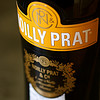
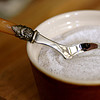
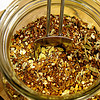
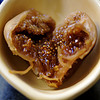
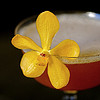
French Sin
– Connaught Bar, London
1/2 fresh fig
1/2T to 1T vanilla sugar
1-1/2 oz Armagnac
1/2 oz amber vermouth
3/4 oz lemon juice
3/4 oz rooibos spiced soda water
Muddle the fig in the shaker with the vanilla sugar, then add the rest of the ingredients — other than the spiced soda water — and shake with ice. Double-strain into a small goblet and top with rooibos spiced soda water, and stir briefly to combine. Garnish with a quarter of a fig.
—
If figs are out of season, look for the freshest dried figs available. Rehydrate them in a small amount of hot (not boiling) water until soft enough to muddle. For garnish, use a lemon twist or a yellow flower, reminiscent of a vanilla orchid.
Vanilla sugar can be purchased in gourmet shops or spice stores — Penzey’s makes a nice one, as does Nielsen-Massey. To make your own, grind a half of a dry vanilla bean in a spice grinder or coffee grinder with a small amount of granulated sugar. Add this vanilla powder to 1 cup sugar and let sit at least 24 hours (and preferably up to a week) before using. In this recipe, you can use the sugar as-is, since you’ll be straining the shaken mixture, but in baked goods or as a general sweetener, use a fine sieve to remove the larger pieces of vanilla pod after the infusing is complete.
To make the rooibos spiced soda, steep 4 tsp spiced rooibos tea (or 1T pure rooibos tea plus a few cardamom pods, whole peppercorns, and cloves) in a quart of hot water for 5 minutes. Strain, chill thoroughly, and charge in a soda siphon.
bar culture, coffee & tea, London, Mixology Monday, recipes
8 Comments »




Posted by Anita on 12.15.08 10:54 PM
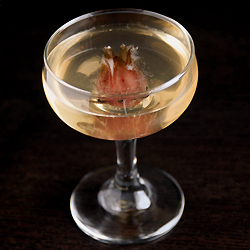 When Sean and DPaul asked me to contribute a signature cocktail to serve with the appetizer course at their holiday soirée last weekend, I kept running into dead ends. For my previous stint behind the Hedonia bar, I’d whipped up a pair of well-received drinks, but for the holidays I wanted to try something a little more classically festive — and what’s more festive than bubbly?
When Sean and DPaul asked me to contribute a signature cocktail to serve with the appetizer course at their holiday soirée last weekend, I kept running into dead ends. For my previous stint behind the Hedonia bar, I’d whipped up a pair of well-received drinks, but for the holidays I wanted to try something a little more classically festive — and what’s more festive than bubbly?
But, if you know those Hedonia boys, you know that their parties are a feast for the eyes as well as the palate; a simple Champagne cocktail — classic though it may be — would not do. No, I needed a conversation starter, a ‘wow’ of a drink that would be sure to set off the beautiful hors d’oeuvres. I toyed with a number of ideas, but kept coming back to the idea of poinsettias and other holiday flowers. Then, while digging through the liquor cabinet, I noticed a jar of candied hibiscus flowers: pretty, festive, and a perfect holiday red.
The purveyor of these little antipodean garnishes suggests dropping one blossom into a flute of bubbly, with or without a splash of its syrup. But even before I remembered Craig‘s choice for this month’s Mixology Monday theme, I knew that I wanted to avoid fruity flavors and move things more into the spice realm.
At first, I tried a simple Champagne and Ginger cocktail, using Domaine de Canton ginger liqueur. Although sweet and pleasant, it really didn’t have the oomph I was looking for. A few hearty dashes of super-spicy whiskey barrel-aged bitters helped a bit, but really didn’t carry the drink into fabulousness.
Then I remembered an experiment from two winters ago. In the days before Domain de Canton hit the shelves, I’d spent a few months trying different techniques to get a strong ginger flavor into a cocktail without using ginger beer, mostly unsuccessfully. But then a “so simple it couldn’t work” idea paid off, and I ended up with a batch of spicy, faintly sweet infusion with a true ginger flavor. A repeat batch of this crystallized ginger digestif turned out to be just the thing to make my holiday sparkler shine.
But back to the garnish: I sampled some of the syrup the blossoms were preserved in, so I had a good handle on their flavor. However, the jar of flowers only held 11 blossoms and I had 10 guests to serve, so I hoarded them all for party night. Little did I know that, instead of the pretty little flowers shown in all the marketing shots, the blooms would become translucent red aliens in the cocktail glass, wicked half-plant/half-animal mutants straight out of a sci-fi movie.
Luckily our hosts and friends were gracious enough to humor our cocktail folly; only one guest refused (vehemently, I might add) to sample the flower, which does indeed taste like a sweet-tart berry. And once the bizarre garnish was gobbled up, everyone asked for refills on their spicy Champagne.
Looking through the photos that DPaul graciously sent over (I managed to bring my camera, but forgot the memory card), I realized that the hibiscus blossom looks like the head of a snake, or a sandworm from the movie version of Dune… a story that’s — appropriately enough — all about spice.

Shai Hulud
1 oz homemade ginger liqueur
– or 1 oz Domaine de Canton plus 1/2 tsp ginger juice
5 dashes Fee Brothers Whiskey Barrel-Aged bitters
Champagne or other dry sparkling wine
candied hibiscus flowers
Measure the ginger liqueur and bitters into a coupe. Top with bubbly and garnish with a hibiscus flower.
Ginger Liqueur
3 oz crystallized ginger chunks
– available in the baking aisle or bulk foods stores
8 oz 80-proof vodka
Combine in a lidded jar. Let steep for two days, then shake; you should notice dark, syrupy threads diluting into the vodka. Continue to steep, shaking once a day, until you reach your desired level of spiciness.
drinks, Mixology Monday, recipes
8 Comments »




Posted by Anita on 11.10.08 12:35 PM
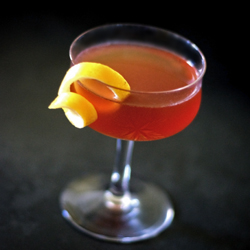 We’re no strangers to homemade cocktail ingredients. We’ve been making limoncello (and other citrus liqueurs) for ages, along with nocino, alkermes, plum brandy, and plenty of other infusions. We’ve simmered up our own grenadine, brewed a batch or two of ginger beer, steeped jar after jar of cocktail cherries, and infused more flavored syrups than any reasonable person’s fridge can hold.
We’re no strangers to homemade cocktail ingredients. We’ve been making limoncello (and other citrus liqueurs) for ages, along with nocino, alkermes, plum brandy, and plenty of other infusions. We’ve simmered up our own grenadine, brewed a batch or two of ginger beer, steeped jar after jar of cocktail cherries, and infused more flavored syrups than any reasonable person’s fridge can hold.
Last summer, we hit upon a new favorite: infused brandy using the excess pears from our friends’ tree. Since it’s an infusion, rather than distilled pear cider, our homemade drink is closer to a pear-brandy liqueur — like Belle de Brillet — than to a potent poire william eau de vie or the grappa-style Clear Creek pear brandy. We’ve mostly sipped it neat or mixed into bubbly, with or without a little simple syrup. But there’s no reason why it wouldn’t be a great mixing ingredient… especially as it doesn’t really improve with age, and in fact deteriorates fairly quickly after the initial infusion.
 There aren’t many cocktails that call for pear spirits, but there are plenty that use calvados and applejack to great effect. One such drink, the Jack Rose, dates to the pre-Prohibition era, and was especially popular in the Northeast where applejack was distilled in great quantity. Many theories abound as to the drink’s name origins, but it seems pretty likely that it’s Jack from booze and Rose from the color, as opposed to any gangster or bartender-nickname references.
There aren’t many cocktails that call for pear spirits, but there are plenty that use calvados and applejack to great effect. One such drink, the Jack Rose, dates to the pre-Prohibition era, and was especially popular in the Northeast where applejack was distilled in great quantity. Many theories abound as to the drink’s name origins, but it seems pretty likely that it’s Jack from booze and Rose from the color, as opposed to any gangster or bartender-nickname references.
The usual recipes for the Jack Rose are split fairly well between lemon and lime juice. When using applejack, I think either option is pleasant, though I will admit a small preference for lime when mixing the stronger Laird’s Bonded. But if you’re making the switch to pear brandy, definitely go with lemons — and Meyer lemons, if you can find them — as the subtler pear flavors are lost amidst lime’s extra tartness.
With a slight change to the more-Frenchified pear brandy, we christen our variation the Jacques Rose. It’s made with all home-made or home-grown ingredients, in honor of Mixology Monday “Made From Scratch,” hosted by The Pegu Blog.
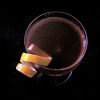
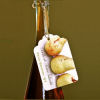
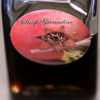
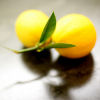
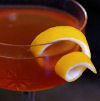
Jacques Rose
2-1/2 oz pear brandy (or substitute 1-1/2 oz brandy + 1 oz poire william)
3/4 oz lemon juice
2-3 dashes grenadine
Shake with ice, and strain into a chilled cocktail glass. Garnish with a lemon twist.
drinks, Mixology Monday, other blogs, preserving & infusing, recipes
3 Comments »




Posted by Cameron on 10.13.08 10:46 PM
 If there is a drink out there with fewer redeeming qualities than the Jäger Bomb, I can’t imagine what it is. Seriously folks, this drink is a bad idea. It tastes like cough syrup, it’s loaded with sugar, it packs enough caffeine to instantly add fifty points to your heart rate, and one of the main ingredients is made entirely of industrial chemicals.
If there is a drink out there with fewer redeeming qualities than the Jäger Bomb, I can’t imagine what it is. Seriously folks, this drink is a bad idea. It tastes like cough syrup, it’s loaded with sugar, it packs enough caffeine to instantly add fifty points to your heart rate, and one of the main ingredients is made entirely of industrial chemicals.
And so, in honor of Stevi’s Mixology Monday topic, Guilty Pleasures, I’m horrified to share with you that I’m completely, utterly addicted to the Trailer Trash Speedball, the Turbojäger, the Flying Hirsch, La Perla Negra: The Jäger Bomb.
I picked up this dirty little habit during my tour of duty as a guitar player for Seattle-area cover band Bad Alibi. For the first three months, I was fastidious about not drinking during performances. To tell the truth, for the first month, I was too panicked to even think about trying to play with a buzz on, which amused my band mates tremendously. They rarely got out of control, but every set was accompanied by beer and, to tell the truth, if our drummer wasn’t stoned, he couldn’t keep time at all.
Before the third and final set of the evening, one of the Alibi Boys would usually buy a round of Jäger Bombs. At first I declined to take part in the toxic trainwreck, but eventually I thought, “Don’t knock it if you haven’t tried it.”
Like any destructive obsession, ritual is an important part of the Jäger Bomb. A shot of Jägermeister, an herbal liqueur, is served next to a pint glass containing half a can of Red Bull energy drink. You drop the shot glass into the pint glass and chug the mixture. Think of it as a millennial boilermaker.
As I climbed back on stage after my first ever Jäger Bomb, I immediately understood the appeal. Our third sets usually ran from midnight to 1:45am. Fridays weren’t too bad, but we always played two nights in a row and the third set on Saturday could be tough. No matter how big the crowd was, by 12:30, the entire room was completely blasted. By 1am, the energy would start to fall off, and by 1:30, the only people upright were usually us and the bar staff.
 This is all by way of saying that if you run around playing high voltage rock and roll late at night, the Jäger Bomb starts to make a lot of sense. One produces a high, fine, jittery feeling, and two will definitely get your motor running. Drink three in quick succession and you might as well hand the bartender your credit card and have them call the cops now, just to save time.
This is all by way of saying that if you run around playing high voltage rock and roll late at night, the Jäger Bomb starts to make a lot of sense. One produces a high, fine, jittery feeling, and two will definitely get your motor running. Drink three in quick succession and you might as well hand the bartender your credit card and have them call the cops now, just to save time.
After about a year and a half of playing 5 hours a night, 2 nights a week, 3 weekends a month in roadhouses anywhere from 45 minutes to 2 hours outside the city, all while holding down a full time corporate day job, my attitude towards rock godhead changed. The crowds were getting smaller, the drives were getting longer, and there is absolutely nothing fun about breaking down the stage at 2am. When I left the band, I mostly stopped drinking Jäger Bombs, as it’s not the sort of thing that you order in polite company.
But every now and then I let the inner Neanderthal come out to play. I drop the shot into the glass, and fire back the mixture. As the tight rush crawls up my spine, I close my eyes and remember when the lights flashed, the fog billowed, and—with one foot on the monitor and a snarl on my lips—I delivered the mighty rock thunder to a sea of dancing hooligans.





Jäger Bomb
4oz of energy drink (roughly 1/2 can of Red Bull)
1 shot Jägermeister
Pour the energy drink in a pint glass. Drop the shot in the pint glass and drink the whole mess down. Rock on.
bar culture, Drink of the Week, drinks, Mixology Monday, recipes, Seattle
13 Comments »




Posted by Anita on 09.15.08 3:41 PM
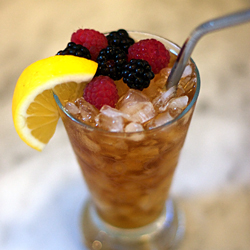 This month’s edition of Mixology Monday, hosted by Dinah and Joe at Bibulo.us, focuses on 19th century libations.
This month’s edition of Mixology Monday, hosted by Dinah and Joe at Bibulo.us, focuses on 19th century libations.
We’re no strangers to this era: Previous editions of Drink of the Week have covered the venerable Mint Julep (1824), Sazerac (1859), Martinez (1862), Manhattan (1870), Ramos Gin Fizz (1880s), Whiskey Sour (pre-1888), Widow’s Kiss (1895), and Horse’s Neck (1897). But, to a greater or lesser degree, all of these drinks have remained well-loved throughout the years.
But what of the Sherry Cobbler, the late 19th century’s most popular drink? What became of the darling that inspired such adulation?
Gin-sling, cock-tail, mint-julep, are about as vulgar as blue ruin and old tom at home; but sherry cobbler is an affair of consideration.
— “Canada and the Canadians“, Richard Henry Bonnycastle (1848)
Most sources date the origins of the Sherry Cobbler to the 1840s — the height of its popularity, to be sure. Digging through web references, I found a mention of it in Washington Irving’s Knickerbocker’s History of New York, Complete, a satirical record of early New York City, first published in 1809:
[Residents of Maryland] lay claim to be the first inventors of those recondite beverages, cock-tail, stone-fence, and sherry-cobbler, and to have discovered the gastronomical merits of terrapins, soft crabs, and canvas-back ducks.
It’s surely a tongue-in-cheek admonition, as the word “cocktail” wouldn’t have been known in the colonial era that our fictional historian details. But despite his tomfoolery, Irving thought that cobblers were sufficiently well-known in 1809 that he could reference it without description — a full 30 years before cobbler-mania’s peak.
There’s hardly a peep about cobblers until the late 1830s, but mid-century publications are chock full of evidence that Sherry Cobbler took England by storm soon thereafter. By 1844, no less a light than Charles Dickens name-checks the drink in his serial novel Martin Chuzzlewit, an otherwise scathing indictment of all things American. In one chapter, the title character’s traveling companion Mark Tapley supplies him with a restorative tipple:
He produced a very large tumbler, piled up to the brim with little blocks of clear transparent ice, through which one or two thin slices of lemon, and a golden liquid of delicious appearance, appealed from the still depths below, to the loving eye of the spectator.
 ‘What do you call this?’ said Martin.
‘What do you call this?’ said Martin.
But Mr. Tapley made no answer; merely plunging a reed into the mixture — which caused a pleasant commotion among the pieces of ice — and signifying by an expressive gesture that it was to be pumped up through that agency by the enraptured drinker.
Martin took the glass with an astonished look; applied his lips to the reed; and cast up his eyes once in ecstasy. He paused no more until the goblet was drained to the last drop.
‘This wonderful invention, sir,’ said Mark, tenderly patting the empty glass, ‘is called a cobbler. Sherry cobbler when you name it long; cobbler, when you name it short.
Presumably upon reading Dickens’s account of ecstasy on ice, British university students were swept up in a cobbler craze. Despite initial problems with substandard ice sourced from fishmongers, the drink’s popularity soared, finding its way into genteel parlors and private gentlemen’s clubs. By 1862, so firmly was the cobbler established that Jerry Thomas devoted an entire section of his Bartender’s Guide to different recipes for cobblers made with sherry, claret, Champagne, whiskey, and sweet wines: hock, catawba, and Sauternes. Thomas tailors ingredients to the base spirit: Often there are oranges (peel or pieces), other times pineapple; an occasional sweet liqueur joins dissolved sugar for added sweetness.
A drink that could be enjoyed by gentlefolk without incurring scorn, it’s only fitting that the cobbler would have its own trinkets. The cobbler popularized the drinking straw; before the 1888 invention of the wound-paper model, hollow reeds or even macaroni strands were used! Cobblers were also, according to some highly reputable sources, the first drinks where ingredients were shaken with ice. I haven’t been able to find primary sources to support that observation, but it’s clear that the Sherry Cobbler craze of the mid-1800s was indeed the force that propelled cocktail shakers into every bar of any size. To this day, a three-piece cocktail mixer with a built-in strainer is known as a cobbler shaker.
Unlike many antique cocktails, this one’s still quite delectable to modern palates; the fresh-fruit garnish and wine base seem downright contemporary. Rescuing this drink from near-obscurity, a new breed of bartenders are cranking up variations coast to coast.
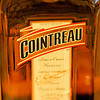

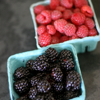
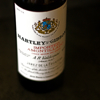
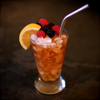
Sherry Cobbler
3 oz medium-dry sherry (such as Oloroso or Amontillado)
1/2 oz Cointreau
1/2 oz simple syrup (or to taste)
2 lemon or orange wedges
berries or other seasonal fruit, for garnish
Squeeze one citrus wedge into an ice-filled cocktail shaker. Add the spent citrus wedge, sherry, Cointreau, and simple syrup, and shake until very cold. Strain into a cobbler glass filled with crushed ice; garnish with the remaining citrus wedge and a riot of fruit, and serve with a straw.
Drink of the Week, drinks, Mixology Monday, recipes
11 Comments »




Posted by Anita on 08.11.08 12:07 PM
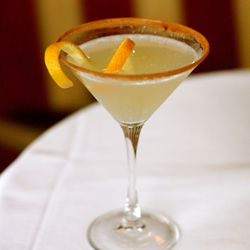 The Bay Area is home to so many fabulous local spirits that it seems almost impossible to single any of them out for special attention. For gin alone, we’ve got 209 and Junipero right here in the City, and Sarticious over the hill in Santa Cruz. We’re close to two top-tier artisan vodka companies — Charbay in Napa and Hangar One on Alameda — both of which also make a variety of other liquors and liqueurs, including St. George Absinthe and Single-Malt Whiskey, and Charbay Rum and Pastis. We’ve got a local brandy-maker, an old-school whiskey distiller, and even a bierschnapps haus.
The Bay Area is home to so many fabulous local spirits that it seems almost impossible to single any of them out for special attention. For gin alone, we’ve got 209 and Junipero right here in the City, and Sarticious over the hill in Santa Cruz. We’re close to two top-tier artisan vodka companies — Charbay in Napa and Hangar One on Alameda — both of which also make a variety of other liquors and liqueurs, including St. George Absinthe and Single-Malt Whiskey, and Charbay Rum and Pastis. We’ve got a local brandy-maker, an old-school whiskey distiller, and even a bierschnapps haus.
But honestly, San Francisco’s best local drinking resource may be its bumper crop of creative mixologists. As Camper pointed out (and I keep harping on at every chance I get), Food & Wine Cocktails 2008 includes an unmatched 17 recipes from SF’s watering holes. The bartenders in our City aren’t just great at mixing up other peoples’ recipes, they’re tops at creating new drinks, too.
San Francisco’s bragging rights as a cocktail-creation mecca can be traced to an illustrious heritage, arguably starting with Jerry Thomas‘s 1880s invention of the Martinez, running through the 1920s with Duncan Nicol’s creation Pisco Punch, and Trader Vic’s Bergeron‘s (oft-disputed) introduction of the Mai Tai in 1944. And — just as today — the City’s always been full of canny restaurateurs popularizing drinks that were invented elsewhere, bringing signature drinks like Irish Coffee to the masses.
 All by way of saying: This month’s episode of Mixology Monday — Local Flavors, hosted by Kevin at Save the Drinkers — has got our name all over it.
All by way of saying: This month’s episode of Mixology Monday — Local Flavors, hosted by Kevin at Save the Drinkers — has got our name all over it.
Now, I’m generally not a fan of tampering with the classics. But here’s one exception: The Cable Car, a clever Sidecar variation with a decidedly local angle. Created by Tony Abou-Ganim in 1996, the drink became the signature cocktail at Harry Denton’s Starlight Lounge, the iconic nightclub perched at the top of the Sir Francis Drake hotel “between the stars and the cable cars”. The Starlight’s specialty drink menu leads off with the Cable Car to this day… no mean feat in a town where cocktails are forgotten before the publicity even hits the presses.
So the Cable Car’s got a good back-story, and a gorgeous home bar. But how’s it taste? Frankly, the sample we sipped last weekend was unworthy of its lofty setting, not to mention its illustrious pedigree. Captain Morgan may be the 900-pound gorilla in the spiced-rum category (not to mention a pop-culture icon), but he’s no friend of my palate. And really, a drink with its roots in France deserves a better orange liqueur than Marie Brizard. I know it gets busy at the Starlight, but I’d like to think that the cocktail world has evolved past the point where a reputable bar resorts to sour mix, even its own house-made stuff.
So let’s bring this one a little closer to today’s standards: Fresh lemon juice, quality rum, a dash of real spice, and a top-shelf orange liqueur. A true San Francisco treat.
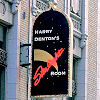
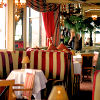
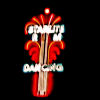
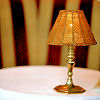
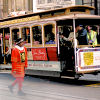
Cable Car Deluxe
– inspired by Tony Abou-Ganim‘s modern classic
1-1/2 oz gold rum (such as Appleton V/X)
scant 1/4 tsp allspice dram
3/4 oz Grand Marnier
1 oz lemon juice
1/2 oz simple syrup (highly optional)
Shake with ice, and strain into a chilled, cinnamon-sugar-rimmed cocktail glass. Garnish with an orange or lemon spiral.
———————-
Other featured cocktails with a San Francisco twist:
-
Bee’s Knees – Our version, made with 100% local ingredients
-
The Soiree – SF Cocktail Week’s signature drink for 2008
-
Martinez – Jerry Thomas invented it here in San Francisco
Drink of the Week from our local bars:
bar culture, Bay Area, downtown SF, Drink of the Week, drinks, locavore, Mixology Monday, recipes
8 Comments »




Posted by Anita on 07.18.08 6:36 AM
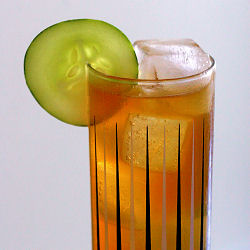 Few of our friends can believe that two people as obsessed with food and drink as we are have never been to New Orleans before. But it’s true: This week is our inaugural — although I think it’s safe to say definitely not our last — adventure in the City that Care Forgot.
Few of our friends can believe that two people as obsessed with food and drink as we are have never been to New Orleans before. But it’s true: This week is our inaugural — although I think it’s safe to say definitely not our last — adventure in the City that Care Forgot.
When Cameron mentioned at poker night last week that we were heading to New Orleans, our friend Dave’s eyes lit up. If there’s a San Franciscan who loves NOLA more than Dave, I sure don’t know him. He and his crew of roving debauchés have made their way to the Crescent City at least once a year for the past 11 years.
He sent us a 1,000-word-plus email, jammed with his favorite places and treats, devoting an entire paragraph (after 10 others on more-obscure offerings) just to the touristy French Quarter food & drink experiences that are actually worth the trouble:
“Get a cafe au lait and beignets at Cafe du Monde! Eat a muffaletta from Central Grocery on Decatur Street! Shoot oysters at Acme Oyster House! Get late-night eats and abuse from flaming waiters at Clover Grill! And drink a Pimm’s cup at Napoleon House bar!”
So, never one to pass up good advice, we hopped over to Napoleon House for lunch yesterday. We sat ourselves down amid glorious decrepitude and a century’s worth of graffiti, and ordered up a round of Pimm’s, a half a muffaletta, and a roast-beef po’boy. Ancient ceiling fans rotated overhead as bow-tied waiters shuttled between table, bar, and patio. Mid-meal, our Seattle cadre wandered in from the sidewalk swelter, followed closely by a friend from the other side of the continent. No fools, these drinkers: It was Pimm’s for everyone; tall, cool, and fast.
The Pimm’s Cup is our entry for this month’s Mixology Monday — aptly honoring the fine city of New Orleans, and even more aptly hosted by MxMo’s founder, Paul of Cocktail Chronicles. Now, frankly, I’m not sure how this quintessential English picnic drink became such a New Orleans standard. But if there were a Jeopardy! category called “Drinks of the Big Easy”, it’d be right there in the middle of the board, below the Hurricane, the Ramos Fizz, and the Sazerac, but above the Vieux Carre, the Obituary, and the La Louisiane. No matter the reason for its iconic status, it’s certainly a long, cool refresher that makes a potent antidote to the sticky New Orleans weather, and it’s known as a respectable option for daytime drinking… a pastime in which the Crescent City excels.


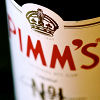

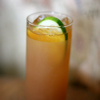
Pimm’s Cup
– Napoleon House, New Orleans
Food & Wine Cocktails 2008
1-1/2 oz Pimm’s No. 1
2-1/2 oz fresh lemon juice
1 oz simple syrup
1-1/2 oz chilled lemon soda (preferably French-style ‘lemonade’, but 7up will do)
cucumber wheel, for garnish
 Add the Pimm’s, lemon juice, and simple syrup to a cocktail shaker. Add ice and shake well, straining into an ice-filled colling glass. Stir in the soda, and garnish with the cucumber wheel.
Add the Pimm’s, lemon juice, and simple syrup to a cocktail shaker. Add ice and shake well, straining into an ice-filled colling glass. Stir in the soda, and garnish with the cucumber wheel.
bar culture, Drink of the Week, Mixology Monday, New Orleans, recipes, Tales of the Cocktail
19 Comments »




Posted by Anita on 06.13.08 7:03 AM
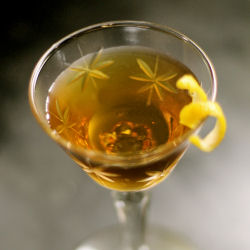 If you follow San Francisco’s cocktail scene even half-heartedly, it’d have been hard to miss the news about Beretta, heir to the old Last Supper Club space on Valencia. Even before its much-anticipated opening, this spot was generating plenty of buzz — much of it due to a bartender roster that reads like a Who’s Who of San Francisco mixologists.
If you follow San Francisco’s cocktail scene even half-heartedly, it’d have been hard to miss the news about Beretta, heir to the old Last Supper Club space on Valencia. Even before its much-anticipated opening, this spot was generating plenty of buzz — much of it due to a bartender roster that reads like a Who’s Who of San Francisco mixologists.
Beretta’s culinary pedigree isn’t too shabby either, and our first dinner there was quite promising. A short list of risotto options — the one we tried, with porcini and Barbera, was homely but delicious — follows a litany of pizzas that could give Gialina or Pizzeria Delfina a run for their money with a few simple tweaks.
A dozen-plus antipasto options included delicious grilled asparagus served with olivata and soft-boiled egg quarters, and a spot-on plate of Monterey sardines in soar. Although portions are modest, this is definitely not dainty “small plates” food. They’re just the thing if you like being able to order a starter without ruining your appetite, and at $5 a pop you can always order two if you’re ravenous. Better still, they’re the perfect size for snacking at the bar while sipping one of Beretta’s well-crafted cocktails.
And yes, it’s all locavore-friendly: The menu boasts of food that’s “always fresh, seasonal, and sourced from local farmers”. Word ’round my office water-cooler is Beretta’s weekend brunch is a crowd-free glory all unto itself — and what better place to nurse a hangover?
Because, really, you might just be tempted overindulge when you see Beretta’s lengthy cocktail menu. Unlike the truncated drink offerings at many restaurants, this list offers a little something for every palate, and all drinks are priced at a reasonable $9. Over the course of the evening, we sampled a fantastic Gin & It made with Vya sweet vermouth and Tanqueray 10, plus an eye-opening Air Mail and pleasantly brisk an Agricole Mule.
 One other drink we tried — the Monte Carlo — bears more than a passing resemblance to an old favorite, the Oh Henry, minus the ginger ale. Lest a fruity liqueur trick you into thinking this is a tame tipple, remember that Benedictine is 86 proof… stiffer than some bourbons! So, I suggest you do as the Beretta barkeeps do and serve it in a dainty Nick-and-Nora glass.
One other drink we tried — the Monte Carlo — bears more than a passing resemblance to an old favorite, the Oh Henry, minus the ginger ale. Lest a fruity liqueur trick you into thinking this is a tame tipple, remember that Benedictine is 86 proof… stiffer than some bourbons! So, I suggest you do as the Beretta barkeeps do and serve it in a dainty Nick-and-Nora glass.
It’s not often we discover a worthy bourbon drink that’s escaped our notice — we’re great fans of America’s brown liquor, and we’ve even been known to put it in our food. So it seems only fitting to share our discovery as part of the June edition of Mixology Monday: Bourbon, hosted by SeanMike at Scofflaw’s Den.
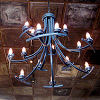
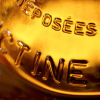

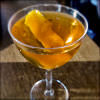
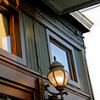
Monte Carlo
1-1/2 oz bourbon or rye
1/2 oz Benedictine
2 dashes aromatic bitters
Stir with ice, strain into a small cocktail glass. Garnish with a twist of orange.
—–
A small sample of previous Drink of the Week entries featuring bourbon:
1/25/08: Horse’s Neck with a Kick
10/12/07: Whiskey Sour
9/14/07: Fashionably Lillet
7/27/07: Mint Julep
7/6/07: Sazerac
11/10/06: Manhattan
8/18/06: Currier
bar culture, Drink of the Week, drinks, Mixology Monday, recipes, restaurants, The Mission
6 Comments »




Posted by Anita on 05.12.08 12:09 AM
 I’m a big fan of Food & Wine magazine’s annual pocket-sized cocktail compilations. I picked up my first edition a few years back as an impulse buy in the supermarket checkout lane. Flipping through the slim volume while the woman in front of me attempted to write a check for her $4 order, I spied a recipe from the Zig-Zag boys and bought it on the spot.
I’m a big fan of Food & Wine magazine’s annual pocket-sized cocktail compilations. I picked up my first edition a few years back as an impulse buy in the supermarket checkout lane. Flipping through the slim volume while the woman in front of me attempted to write a check for her $4 order, I spied a recipe from the Zig-Zag boys and bought it on the spot.
Every year since then, I’ve waited impatiently for the new version each spring. Though I don’t always find a new favorite, there are enough “keeper” recipes in every edition that it’s worth the small expense — about $10 — and the photography and prop styling offer plenty of visual inspiration.
This year’s edition features a whopping 17 recipes from Bay Area bars and restaurants, including favorites like Nopa, Forbidden Island, Alembic, and more. Surely, I thought, there must be a good rum recipe in there, worthy of this month’s Mixology Monday roundup — hosted, aptly enough, by Trader Tiki.
Alas, somebody at F&W missed the memo about rum’s hot streak: A good chunk of the drinks in the Rum chapter are actually made with rum’s Brazilan cousin, cachaça. But one concoction did catch my eye: Scott Beattie’s “Thai Boxer” — a vanilla-rum drink that uses unsweetened coconut milk, muddled Asian herbs, and a dose of ginger ale. Truthfully, I’m not a huge fan of culinary cocktails that require a grocery-store excursion, but it just so happens that (a) I keep a case of coconut milk on hand for Thai curries and (b) we actually have all the herb ingredients growing in our yard.
Much as I love the folks at Charbay, I was reluctant to splash out $35+ for a bottle of their boutique vanilla rum, not knowing if I’d find another use for it. Perhaps it was a blessing in disguise: There wasn’t a single bottle to be found at any of my regular liquor shops. Happily, spiced spirits are one of the quickest and easiest infusions to make, and I was very pleased with my first effort at home-made vanilla rum.
But back to the recipe: Once the shopping’s done and the vanilla rum’s steeped, the hard part’s definitely done. I took the liberty of replacing the original recipe’s simple syrup with an equal amount of Canton ginger liqueur to double up the ginger beer’s flavor. Much like its namesake, this Thai Boxer’s a cute little thing with a surprisingly lethal kick.
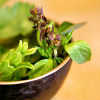
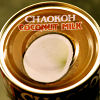
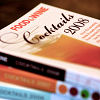
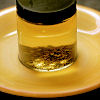
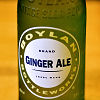
Thai Boxer
– Adapted from a recipe by Scott Beattie in Food & Wine Cocktails 2008
10 leaves Thai basil, plus a sprig for garnish
 10 leaves fresh mint
10 leaves fresh mint
10 leaves cilantro
1/2 oz Canton ginger liqueur, or simple syrup
1-1/2 oz vanilla rum (see Note 1)
1 oz lime juice
1/2 oz unsweetened coconut milk (see Note 2)
ginger beer, or a quality ginger ale
In a mixing glass, muddle the herbs with the liqueur or syrup. Add the rum, lime juice, coconut milk, and shake with ice until well chilled. Double-strain (using a Hawthorne strainer to hold back the ice and a fine sieve to catch the bits of herbs) into an ice-filled highball glass, and top with ginger beer. Garnish with a spring of Thai basil.
Note 1: If you can’t find a natural vanilla rum — Beattie recommends Charbay Tahitian Vanilla, which seems to be in short supply, even here in the Bay Area — it’s easy to make your own. Split and finely grind (or chop) a vanilla bean and steep in 8oz of white rum. Shake periodically, and strain through cheesecloth after 48 hours. Whatever you do, please steer clear of the artificially enhanced mass-market brands.
Note 2: You’re looking for the unsweetened Asian stuff here, not that ‘coco creme‘ crap. Try to not shake the coconut milk before using. In fact, it’s best if you can refrigerate the can for a day beforehand to allow the coconut cream to rise to the top and solidify. Be sure you’re using the thinner, watery milk at the bottom of the can for this recipe, or you’ll end up with an unappetizing film on the sides of the glass and a greasy-tasting drink.
—–
Other Drink of the Week posts featuring Rum:
Millionaire Cocktail #1 with Plymouth Sloe Gin
Fugu for Two at Forbidden Island
Dark & Stormy, San Francisco’s winter fave
Mai Tai at the Tiki-ti
Piña Coladas, au naturel
Mojitos a la Murray
Corn ‘n’ Oil, Cameron’s favorite rum drink
Bloody Beach, a Blood and Sand variation
Eggnog for a festive occasion
Painkillers straight from Tortola
Jolly Roger, for Talk Like a Pirate Day
Canton (aka Chinese Cocktail), the very first DOTW
cookbooks, Drink of the Week, drinks, Mixology Monday, recipes
9 Comments »




 The great irony of these troubled economic times is that cocktail budgets are shrinking just at the time when many of us really could use a strong drink. And even if you’ve survived the entire economic downturn syndrome — the downsizing, the furloughs, the real-estate bubble, and the credit crunch — unscathed, it feels a little too much like tempting fate to be drinking high on the hog while waiting for the other shoe to drop.
The great irony of these troubled economic times is that cocktail budgets are shrinking just at the time when many of us really could use a strong drink. And even if you’ve survived the entire economic downturn syndrome — the downsizing, the furloughs, the real-estate bubble, and the credit crunch — unscathed, it feels a little too much like tempting fate to be drinking high on the hog while waiting for the other shoe to drop.















































 One other drink we tried — the Monte Carlo — bears more than a passing resemblance to an old favorite, the
One other drink we tried — the Monte Carlo — bears more than a passing resemblance to an old favorite, the 










